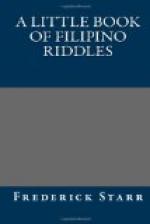Daluang balon
hindi malingon
or
Bahay ni San Gabriel
punong puno nang barel.
Just as in European riddles certain set phrases or sentences are found frequently at the beginning or end of the riddle. In Ilocano and Pangasinan a common introductory form is “What creature of God” or “What thing made by Lord God,” the expression in reality being equivalent to a simple “what.” These pious forms do not at all necessarily refer either to animals or natural objects; thus, a boat or a house is just as good a “creature of God” as a fowl is. A common form of ending is “Tell it and I am yours,” “Guess it and I am your man.”
Quite analogous to calling inanimate or artificial things “creatures of God” is the personification of all sorts of things, animate and inanimate; thus, a rat is “an old man,” a dipper is “a boy.” Not infrequently the object or idea thus personified is given a title of respect; thus, “Corporal Black” is the night. Akin to personification is bold metaphor and association. In this there may or may not be some evident analogy; thus a crawfish is “a bird,” the banca or canoe is “rung” (like a bell.) Not uncommonly the word “house” is used of anything thought of as containing something; thus “Santa Ana’s house,” “San Gabriel’s house;” this use is particularly used in speaking of fruits. “Santa Ana’s house is full of bullets” is rather pretty description for the papaya. The word “work” is often used for a thing made, or a manufactured article.
Saints’ names are constantly introduced, generally in the possessive case; examples are “Santa Ana’s house,” “Santa Maria’s umbrella,” “San Jose’s canes.” Less commonly the names of other Bible worthies occur; thus “Adam’s hair.” There is not always any evident fitness in the selection of the Saint in the connection established. San Jose’s connection with rain is suitable enough. One would need to know a good deal regarding local and popular hagiography in order to see to what degree the selections are appropriate.
Sometimes words without meaning, or with no significance in the connection where they occur are used. These may serve merely to fill out a line or to meet the demands of metre. Such often appear to be names of the style of “Humpty Dumpty;” these may be phonetically happy, as similar ones often are in European riddles, fitting well with the word or idea to be called up. Marabotania is probably meaningless, merely for euphony. Place names with no real connection with the thought are frequently introduced, as Pantaleon, Mariveles. “Guering-guering” and “Minimin” are merely for sound.
Particularly interesting and curious are the historia-vino given in numbers 312-317. No doubt there are many such. Those here given were secured from one boy at Malolos. When first examined, I believed the boy had not understood what I was after. He assured me that they were bugtong and bugtong of the best and finest class. The idea in these is to propound a statement in a paradoxical form, which calls for some reference to a bible story or teaching; the answer is not immediately clear and demands a commentary which is quite often subtle and ingenious. Friedreich gives examples of similar expository religious riddles from Europe.




